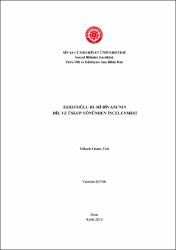| dc.contributor.advisor | Yücel, Bilal | |
| dc.contributor.author | Bıyık, Yasemin | |
| dc.date.accessioned | 2020-01-28T12:21:51Z | |
| dc.date.available | 2020-01-28T12:21:51Z | |
| dc.date.issued | 2019 | tr |
| dc.date.submitted | 2019-09-05 | |
| dc.identifier.other | XIII, 469 sayfa | |
| dc.identifier.uri | https://hdl.handle.net/20.500.12418/12172 | |
| dc.description.abstract | Eski Anadolu Türkçesi döneminde, eski Türk yazı dili geleneğinin izleri ile Arap-Fars yazı sisteminin Türkçeye uygulanmaya çalışıldığı görülmektedir. Bu durum dilin ses ve biçim özelliklerini yansıtmada farklı yazımlar şeklinde kendini göstermiştir. Ayrıca kelime hazinesindeki yenilikler ve farklı biçim özellikleri de bu dönemin genel özellikleri arasındadır.
Bu çalışmada, Eşrefoğlu Abdullah-ı Rumi’nin Millî Kütüphane Yazmalar Koleksiyonu 06 Mil Yz A 3306 adlı arşivde kayıtlı olan Divan’ı üzerinde çalışılmıştır. Eserin müstensihi Hasan Vasfi, istinsah tarihi ise 1255 (1839-40) yılıdır. 121 varaktan oluşan bu eserde 154 tane şiir bulunmaktadır. Giriş, İnceleme, Metin, Dizin ve Sonuç olmak üzere beş ana bölümden oluşan bu çalışmada bu bölümlerin dışında en sona da eserin tıpkı basımı ilave edilmiştir. Arap alfabesiyle yazılmış olan Divan, transkripsiyonlu olarak okunmuştur ve dil tarihi açısından önemi dikkate alınarak inceleme kısmı meydana getirilmiştir. Düzeltmesi yapılan kelimelerin metindeki biçimleri dipnotta gösterilmiştir. Giriş bölümünde Eşrefoğlu Rumi’nin hayatı, edebi kişiliği ve eserleri hakkında bilgiler; İnceleme bölümünde eserin yazım, ses, biçim ve üslup özellikleri hakkında bilgiler; Dizinde sözcüklerin alındığı dil (Türkçe sözcükler hariç), metinde kullanılan anlamı, aldığı ekler, geçtiği şiir ve beyit numaraları, metinde aynı anlama gelen fakat yazımı farklı olan kelimeler ayrı madde başı olarak verilmiştir.
İncelenen metinde Eski Anadolu Türkçesi özelliklerinin yanı sıra Türkiye Türkçesi özellikleri de büyük oranda görülmektedir. Eser üzerinde yapılan bu çalışmadaki asıl amaç yazım, ses, biçim ve üslup bilgisi bakımından yazıldığı dönemin ve istinsah edildiği dönemin özelliklerini esere nasıl yansıdığını incelemek ve eserin söz varlığını ortaya çıkarmaktır. Metnin söz varlığı, Dizin’den faydalanılarak tespit edilmiştir. Zengin söz varlığına sahip olan eserin dili, Arapça ve Farsça kelimeler Türkçe kelimelerden fazla olmasına rağmen anlaşılırdır. Şairin asıl amacı sanat yapmak değil, dinî-tasavvufi görüşlerini halka yaymaktır. Anlaşılır bir dil kullanmak bu bakımdan önemlidir. | tr |
| dc.description.abstract | In the period of Old Anatolian Turkish, it is seen that the traces of the old Turkish written language tradition and the Arabic-Persian writing system were tried to be applied to Turkish. This situation manifests itself in the form of different spellings to reflect the sound and form characteristics of the language. In addition, innovations in vocabulary and different form features are among the general features of this period.
In this study, the Divan of Eşrefoğlu Abdullah-ı Rumi, which is recorded in the archive of the Millî Library Yazmalar Collection 06 Mil Yz A 3306, was studied. The work of artifact is Hasan Vasfi and the date of the invasion is 1255 (1839-40). This work consists of 121 pages and 154 poems. In this study, which consists of five main chapters: Introduction, Analysis, Text, Index and Conclusion, in addition to these chapters, the last edition of the work is added. The Divan, which was written in Arabic alphabet, was read in transcription and the examination part was created considering the importance of the history of language. The format of the corrected words in the text is shown in the footnote. In the introduction, information about Eşrefoğlu Rumi's life, literary personality and works; In the examination section, information about the spelling, sound, form and style features of the work; The language in which the words are taken in the index (except Turkish words), the meaning used in the text, the suffixes, the poems and couplet numbers in the text, the words that have the same meaning in the text but which have different spelling are given as separate headings.
In addition to the features of Old Anatolian Turkish texts studied in Turkey Turkish properties it is seen at great rates. The main purpose of this study on the work is to examine the characteristics of the period in which it was written and the period in which it was written in terms of spelling, sound, form and style knowledge and to reveal the vocabulary of the work. The vocabulary of the text was determined from the Index. The language of the work, which has a rich vocabulary, is understandable although Arabic and Persian words are more than Turkish words. The main purpose of the poet is not to make art, but to spread his religious-mystical views to the public. It is important to use a clear language. | tr |
| dc.language.iso | tur | tr |
| dc.publisher | Sivas Cumhuriyet Üniversitesi - Sosyal Bilimler Enstitüsü | tr |
| dc.rights | info:eu-repo/semantics/openAccess | tr |
| dc.subject | Eşrefoğlu Rumi | tr |
| dc.subject | Eski Anadolu Türkçesi | tr |
| dc.subject | Divan | tr |
| dc.subject | İnceleme | tr |
| dc.subject | Transkripsiyonlu Metin | tr |
| dc.subject | Dizin | tr |
| dc.subject | Tıpkı basım | tr |
| dc.title | Eşrefoğlu Rumi Divanı'nın Dil ve Üslup Yönünden İncelenmesi | tr |
| dc.type | masterThesis | tr |
| dc.contributor.department | Sosyal Bilimler Enstitüsü | tr |
| dc.relation.publicationcategory | Tez | tr |















